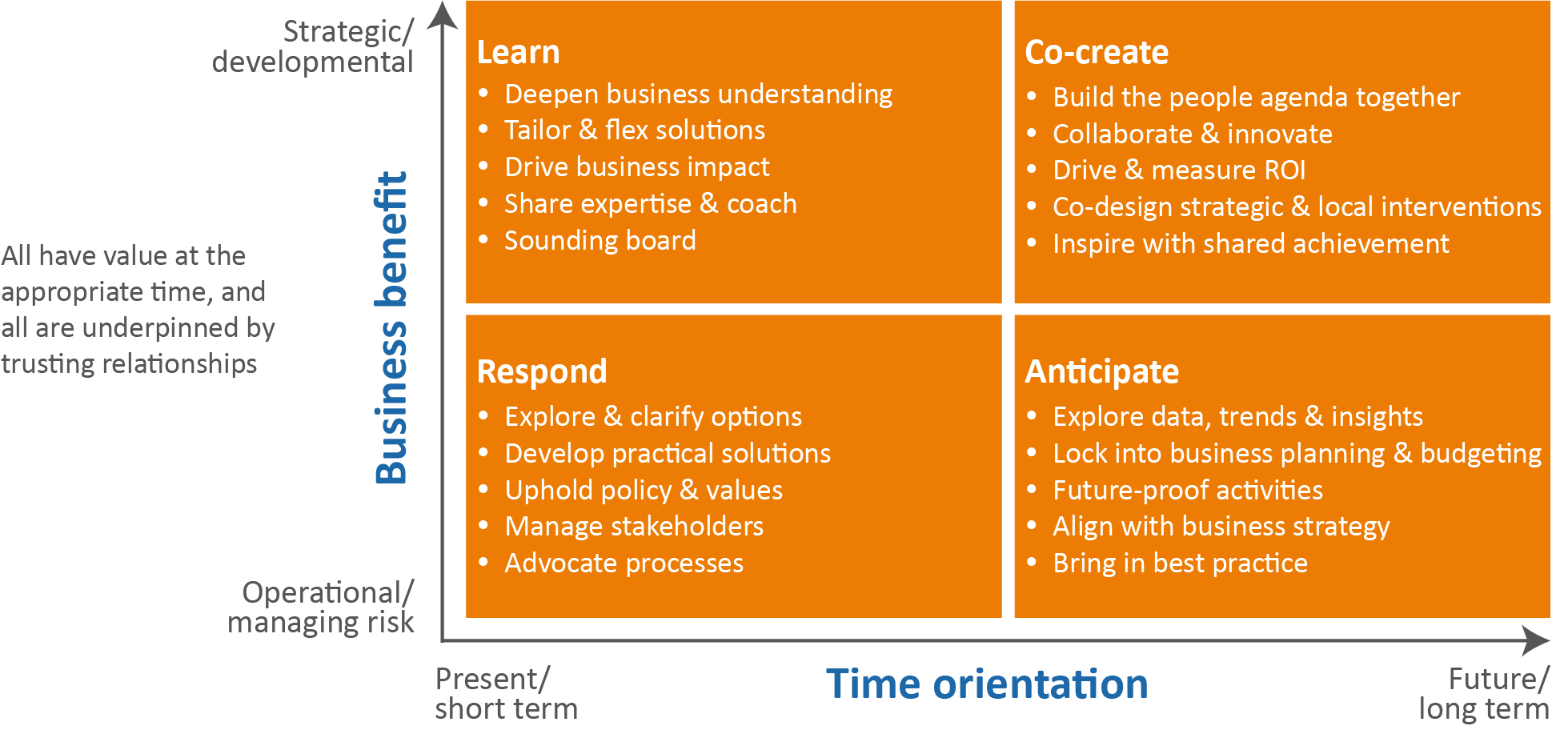How to make business partnering work
It’s more than a role – it’s an attitude, an ambition and a driving force to raise the level at which HR operates. It transforms how HR interact with stakeholders, which leads to transforming what HR can deliver, and how they’re regarded.
A good HRBP can be a powerful conduit to understanding business reality and deploying HR’s resources effectively. But only if there is proactive leadership from the CHRO
Business partnering has to be led from the top. What is the business rationale? How will it work as a strategic principle as well as an operational relationship?
Let’s start with the big picture why and then we’ll come back to the operational implications and the daily life of the HRBP.
In what way will this restructure – for it has to involve more than a different job title – contribute towards strategic goals?
All senior leaders need to be on board with the why. ‘It has to be more than the CHRO saying ‘I want this model’ – there has to be a business rationale’, says Asad Husain, four times CHRO in leading global organisations. ‘The CHRO needs to have fully imagined how it will play out and work, how it will be different and what their role will be – how things will be different.’
Business partnering is one element in a strategic rethink of how HR can add more value.
As always, context is key. What else is changing? Is this part of an organisational transformation, where the business rationale is clear? To what extent are the HR systems and processes geared up to support a more client-driven way of working? Expecting more from the HR professional in the role is unfair – and won’t deliver – if the conditions are not created for them to succeed.
That comes down to the relationship between the CHRO and CEO. This plays out at every level, right down to the HRBP – they won’t be able to deliver unless they are supported by leadership across the organisation. ‘In this’, says Asad Husain, ‘the size of the company doesn’t matter.’
How well equipped is your existing HR talent to fundamentally shift their stakeholder relationships?
Let’s look now at the individual HRBP and how they shift the relationship so that they are able to add value at a higher level. Moving towards business partnering is actually achieved conversation by conversation – explaining and advocating the benefits of deploying the HRBP’s expertise more strategically.
If we assume that the strategic rationale is clear and supported, then the HRBP still needs to explain to their stakeholders what this means in practice. Often this means that they can no longer take on as much from the line manager, who has to be more self-sufficient in some areas in order to leave the time and space to engage with the BP more strategically in others.
Where this isn’t handled well, or where trust isn’t in place, the line manager can feel disappointed, frustrated that they can no longer ‘dump’ issues on the HR professional, and is likely to take it to their own boss. ‘HR are being unhelpful’, is a complaint I’ve heard made. The way the line manager’s boss deals with this is pivotal. Do they say ‘yes, I understand why the HRBP is saying that, let me explain the rationale …’ or do they say ‘that’s not right, I’ll sort it,’ and head off to complain to HR at their level.
The quality of leading and managing performance is the acid test of business partnering
To see how this plays out, let’s look at a typical scenario faced by the HRBP. The line manager – we’ll call them ‘Jan’ – has a performance issue in their team. For the busy HRBP as well as the stressed line manager, the most time-effective solution in the short term might be to ‘sort this out for me’ as requested by Jan.
It’s at this point that the HRBP makes a critical decision – which may take more of their time in the short term, but deliver more in the long term. Will they take the time right now to explain how they can add more value if they handle this differently? If they do this successfully, they can coach the line manager and achieve a better longer term solution.
The change in the way the HRBP and line manager work together has to be explained within the business context – the benefits that it will deliver
We developed the Business Partnering Matrix, below, to clarify how the HRBP can move the conversation forwards. All four modes have value at the appropriate time, but it’s important for the HRBP to ask their self two key questions about where the conversation is going:
- To what extent am I talking with Jan about the business (and not HR)
- To what extent am I talking with Jan about the future (and not the present).
These two factors will build outcomes that deliver greater value and build more trusting and robust relationships.

A great HRBP shows a genuine curiosity and appetite for getting under the skin of what drives business success
Let’s go back to Jan and the performance issue. A business-savvy HRBP will use experience and data to provide a deeper analysis of the impact of performance issues, e.g. ‘Jan, I reckon that you’re having to spend a day a week dealing with team members who aren’t meeting the required standards.’ That will get Jan’s attention to the broader issue and the need to improve his own skills.
The HRBP can take this logic to Jan’s boss, and point out ‘You’ve got 10 Jan’s struggling to get the performance they need from their teams. When we add up all that time, it’s a big number. We could spend that on training them and increase productivity as well as reducing attrition.’
The rewards come when the operational outcomes turn the strategic vision into reality
This example applies at every level of the organisation, and across every function. Whether you’re focused on productivity, performance, wellbeing, engagement, customer … it’s the small things that add up to the big numbers.
The maturity of leaders and how they view their responsibility in leading and managing performance is another important element. ‘The CHRO has to lead the entire company’, says Asad Husain; ‘you have the reach and the breadth of exposure and the power to ensure that leaders follow the process that was agreed by the business’.
Business partnering demands strategic support if it is going to deliver strategic value
Too often, as I hear from many HRBPs in our workshops, senior leaders expect the HRBP to achieve some kind of magical transformation on their own. Good HR people, whatever their role title, will always seek to understand the business, raise the level of the conversation, coach and challenge the line manager to manage their people well.
The business partner has to use examples in the moment to explain the rationale behind the bigger picture. The performance issue that’s happening right now, for example, is an opportunity to explain how HR can add more value if they work on the cause rather than the repeated effect.
Achieving true partnering takes work – and leading this from the top is the best route to ensuring that HR deliver what the business needs
Whatever the HRBP is facing at the front line with the line manager, and how well they can deliver the transformation in how HR relates to the business, depends on the level of understanding and commitment that exists at the most senior level of the organisation.
The true power to make it work comes from strategic business alignment – a clearly articulated business case that can be shared at every level of the organisation.
Find out more about our HR business partnering programme
Deborah Wilkes, Article for HR Zone, April 2022


